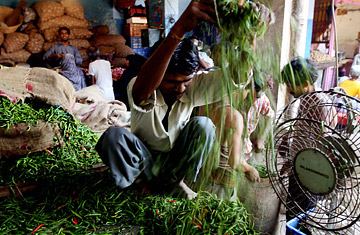
An Indian vegetable vendor sorts chilies at a local market in Mumbai.
Inflation in India has hit a 13-year high, but you wouldn't know that as you walk around the Infiniti Mall in Andheri, a Mumbai suburb. The young men and women — many of whom are aspiring models and film stars (the Bollywood studios are not far from here) — are crowding in with their cell phones and laptops, and the place looks as busy as ever.
Visiting a stall that serves bhelpuri — a mix of puffed rice, dough, tomato and coriander that is the quintessential Mumbai snack — I find that the price has gone up from 37 rupees a plate to 42 (about $1), in line with the current inflation rate of 12%. I ask the manager of the stall if sales have slowed down at the higher price. He thinks this is funny, and he shares my question with his workers; they think it's funny too. One of them explains: "If you were happy to pay 37 rupees for a plate of bhelpuri, do you think you'd even notice an increase?" The cost of the dish here is four times what you'd pay out on the street. For these workers, who cannot afford to buy a thing in this mall, not even a bottle of water, everything seems surreally expensive; the surreal getting inflated by 12% isn't an event at all.
When I get to my apartment, I find Suman, the maid who does the cleaning in my building, waiting outside the door. The price of lentils, a key component of most Indian meals, has surged in the past few months. She hasn't been able to increase her rates yet, so she has had to take an additional cleaning job to make sure there is enough food at home. She will have to leave my apartment sooner every day; she hopes I will not dismiss her for this.
Over the past decade, economists have been divided about the great Indian boom. For one party, the Indian economy's amazing growth rates indicate that the country is a nascent superpower — an America in the making. As evidence, they can point to the growing clout of Indian firms like Bennett, Coleman & Co., a privately owned Mumbai media conglomerate that recently bought Britain's Virgin Radio. For the other group of economists, the boom has been an illusion: the majority of Indians have been excluded from the growth, poverty has stayed stagnant, and India is still just a Sudan with a little icing on top. So who is right? As the current bout of inflation shows, they are both right.
The Indian economy is slowing this year, but even if it grows at only 7% or 8%, it will be doing far better than the U.S. and most of Europe. The Indian multinationals that have grown out of the 10-year boom look as strong as ever, with outsourcing giants like Infosys and Tata Consulting Services growing very robustly. Their success has created a huge middle class for which 12% inflation is more of a nuisance than a worry. The long-term future of the Indian middle class is secure. The factors that have driven its success — a sure grasp of English, a facility with technology, a talent for innovation — will continue to be important in the global economy.
But the 300 million or so Indians living in acute poverty are being crushed
by inflation. If they thought washing the floors, driving the cars and
cleaning the windows of the middle class would open the doors to a better
life, they know now that they were wrong. With prices rising, their savings
are being eaten away. Higher food and fuel prices are being driven by big
changes in the global economy that look set to continue. Even the most
cheerful optimist in the past decade has seen the huge divide between the
haves and have-nots, but the hope has persisted that it would somehow go
away. Inflation has set like cement into that divide, solidifying the gap
between the two Indias. The future for the country is two futures: rosy and
grim. Indian companies will buy more foreign businesses and more Indian
children will starve. In economic terms, India has become neither the U.S.
nor Sudan, but something in between — a Latin American republic with an
entrenched class chasm. Higher levels of crime and social unrest are almost
certain to follow. For years or decades to come, we will not be able to talk
of one destiny for all the people of the country.
Aravind Adiga is the author of the novel The White Tiger
